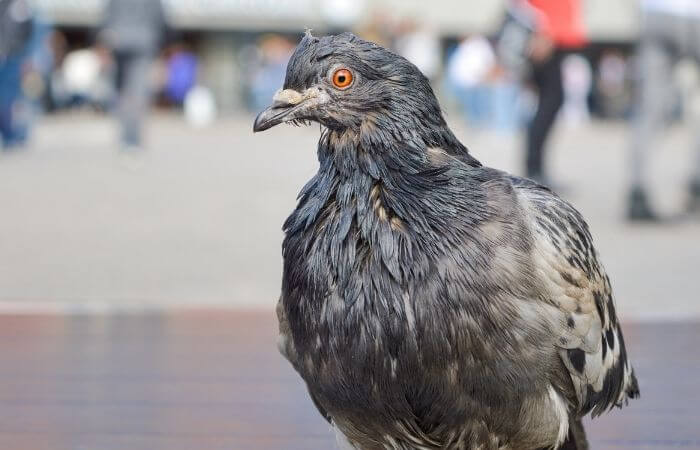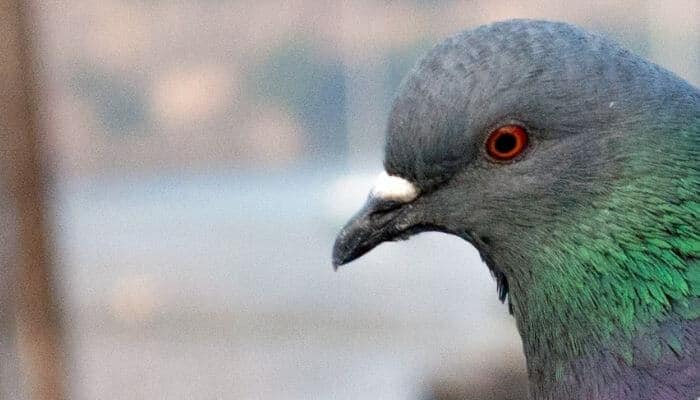Avian mycoplasmosis affects a very wide range of bird species, including pigeons.
The two most common types are Mycoplasma synoviae and Mycoplasma gallisepticum, but they tend to affect farmed birds (chickens and turkeys, in particular) rather than pigeons and other species.
Pigeons typically get either Mycoplasma columborale or Mycoplasma columbinum.
In today’s article, we’re looking at everything you should know about mycoplasmosis in pigeons.
How do pigeons get mycoplasmosis?
First of all, the pathogen that produces this disease is a bacterium, and while this might make you believe that it’s easier to treat than a viral disease, this is a myth.
The reason mycoplasmosis is so challenging to treat is that many birds are carriers and do not show any symptoms at all throughout their life.
However, this also means that they can pass it on to any other pigeon they cohabitate with.
Even though the pathogen isn’t capable of surviving for a long time outside the body of a pigeon, the most common way of transmission is by sharing food and water bowls.
Since most of the symptoms that the condition causes involve the respiratory tract, the birds expel the pathogen through fluid discharge from their sinuses (by sneezing, for example).
All types of pigeons can be affected by mycoplasmosis, including racing pigeons.
They can become infected by coming into close contact with other birds, whether wild ones or not.
One study performed in the United Kingdom revealed that 28% of a group of 58 pigeons were Mycoplasma spp. carriers.
Even though the main transmission method is contact with other birds, there are other vectors.
Poor hygiene, along with the presence of rodents or other animals in the pigeon living area are two other factors.

Moreover, even though avian Mycoplasma species can’t be transmitted to humans, you can be a vector.
If you have been around other pigeons that have Mycoplasma, even if you haven’t touched them, you might inadvertently carry the pathogen on your shoes, clothes, or even on your hair.
Mycoplasmosis symptoms in pigeons
Despite this germ causing disease in a number of varied species, from ducks and geese to guinea fowl and racing pigeons, it tends to cause the same clinical signs in all of them.
Mycoplasma causes catarrhal rhinitis, pneumonia, as well as tracheitis, and sinusitis.
It can sometimes also lead to the edema of the air sac walls.
A generalized form exists, too, where the birds start showing respiratory signs at first, but then the pathogen affects non-specific organs, too, mostly from their abdominal cavity.
The following signs can be noticed in pigeons that have mycoplasmosis:
- A runny nose
- A persistent cough
- Unusual breathing sounds
- Inflammation in the face and eyelids
As the disease progresses, the pigeons might become unable to stand on their feet, experience lethargy, and their feathers could be ruffled, as well.
Blotchy skin and swollen joints can be two other symptoms that pigeon owners might notice.

A lack of appetite for both food and water can be seen in these birds, but that’s mostly because they also become incapable of feeding due to the local inflammation.
Not all pigeons experience the same symptoms, which can make diagnosis a little challenging.
Just like bird flu, some birds can be much sicker, while others might have no apparent clinical signs at all.
Diagnosis
There are several different ways of diagnosing mycoplasmosis in pigeons, and your veterinarian might make use of a number of them.
The vet could collect a blood sample, a swab from the trachea of your pigeons, or even the eggs that some of them might have laid.
Unfortunately, if some of your birds have become so sick that they have died, the vet will ask you to take their corpses and transport them to the vet clinic as soon as possible so that they can perform a necropsy.
The bodies can reveal the deposits that this disease is characterized by in most segments of the respiratory tract.
Fibrinous deposits might also be revealed in the birds’ peritoneal cavity.
How can mycoplasmosis in pigeons be treated?
Antibiotics are typically effective in treating this disease, but unfortunately, it needs to be diagnosed as early as possible.
If not, some of the birds develop such severe symptoms that even adequate treatment might not help them recover.
A particularly important note that we must make with regard to this infectious disease is that even if the pigeons do recover, they could be carriers for the remainder of their lives.
This means that if you let them go out in the wild, the likelihood of them infecting other birds, which they could come in contact with, is going to be quite high.
Some of the most commonly used antibiotics in pigeons are doxycycline, enrofloxacin, ampicillin, and erythromycin.
Even if you have access to any of these antibiotics, you should not give your pigeons the treatment with no guidance from a veterinarian.
The reason for this is that the strain of Mycoplasma that your pigeons might have become infected with might not be sensitive to that particular antibiotic.
While diagnosing the disease, the veterinarian will collect samples for microscopic examinations, but will also send some to a lab where a bacteriological examination will be performed, followed by an antibiogram.
The antibiogram is a Petri dish where several samples of the germ solution are deposited on a number of small antibiotic dosages.
This examination reveals how sensitive that particular germ is to one medication or the other.
Some Mycoplasma strains can be resistant, mildly sensitive, or sensitive to various antibiotics, so getting in touch with your vet whenever your pigeons exhibit any respiratory symptoms can lead to the correct treatment being prescribed.
Prevention of mycoplasmosis in pigeons
Cleaning your bird feeders and waterers on a regular basis and using a solution of domestic bleach for disinfection can prevent the disease to some extent.
However, you have no control over what birds your pigeons come in contact with outdoors.
Try to keep your pigeon enclosures lightly populated.
When pigeons live too close to one another, if one becomes sick, the entire flock will develop the disease.
Isolate the birds that are showing any symptoms and ask your vet to come and examine them.

This article was written by our qualified veterinarian Cristina.
This is part of our commitment to providing you with the most trustworthy veterinary advice for your pigeons.
Resources:
